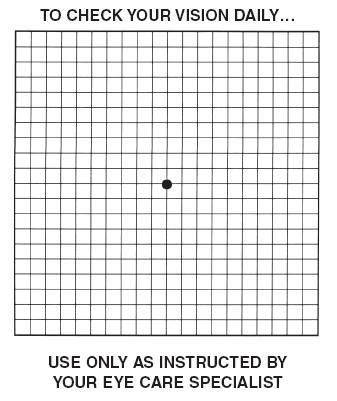Blog

Macular Degeneration Awareness Month
Posted: Tuesday 25th February 2020
What is it?
Many of us have heard of or know someone with age-related macular degeneration (AMD) but may not know how it affects vision. The macula is the focal point of the retina (the light sensitive membrane at the back of the eye) responsible for detailed vision and thus it is reading and other detailed work which is affected. Usually AMD begins with distortion or blurring but it can also cause dark or missing patches in the vision. AMD occurs when the pigmented layer of the retina becomes faulty. Deposits can build up under the retina and if these become large enough to affect the vision it is called dry AMD. If breaks in the protective outer layer happen allowing leaky new blood vessels to grow into the retina this is wet AMD. Early dry AMD may not affect vision very much and it may be many years before it develops enough to cause problems. However people with dry AMD are at increased risk of wet AMD which causes rapid deterioration and needs urgent treatment.
Who can get it?
Age is the major risk factor along with smoking which increases the risk of AMD by 4 times. There is a hereditary element and so people with relatives with AMD can be more at risk. Around 1.5 million people in the UK are affected by macula diseases and dry and wet AMD make up the largest proportion of these and are the highest cause of vision loss in the UK.
How can I be checked for AMD? OCT eye health scans can be used to check the health of the macula and monitor AMD. At Rawlings Opticians we use multiple OCT scans and photography to assess the macula. This painless 5 minute process is not covered by the NHS but can be done alongside your usual NHS eye test. A chart called an Amsler grid can be used to check for distortion of vision and you can also do this at home in between eye tests – any change in the appearance of the grid should prompt a same-day phone call to your opticians to arrange further tests.
Print the Amsler Grid
OCT eye health scans can be used to check the health of the macula and monitor AMD. At Rawlings Opticians we use multiple OCT scans and photography to assess the macula. This painless 5 minute process is not covered by the NHS but can be done alongside your usual NHS eye test. A chart called an Amsler grid can be used to check for distortion of vision and you can also do this at home in between eye tests – any change in the appearance of the grid should prompt a same-day phone call to your opticians to arrange further tests.
Print the Amsler Grid
How can I help myself?
A healthy diet including richly coloured fruit & vegetables such as kale and corn can increase the pigment in the macula, as well as eggs. Foods containing omega 3 fatty acids are also recommended. A study at Aston University lead to the recommendation of 2 eggs a day or 150g of kale or spinach for cases of early dry AMD and vitamin/pigment supplements for more advanced cases. These supplements are widely available, and long term clinical studies are underway to provide better evidence of how helpful they are. Not smoking is vital and your GP can help you with this. Keeping a healthy weight and taking regular gentle exercise is also important, and protection by sunglasses and a peaked hat reduces the risk of retinal damage from UV. Use your grid chart regularly if instructed to do so and make sure you have regular eye examinations with OCT. If you have any concerns that your vision has changed you should contact us & explain your concerns so that we can arrange to see you quickly, do not wait until your next appointment is due – even if that is only a few weeks away.
If you would like to book an appointment please contact us or book online.
Find out more at https://www.macularsociety.org.
< Back




